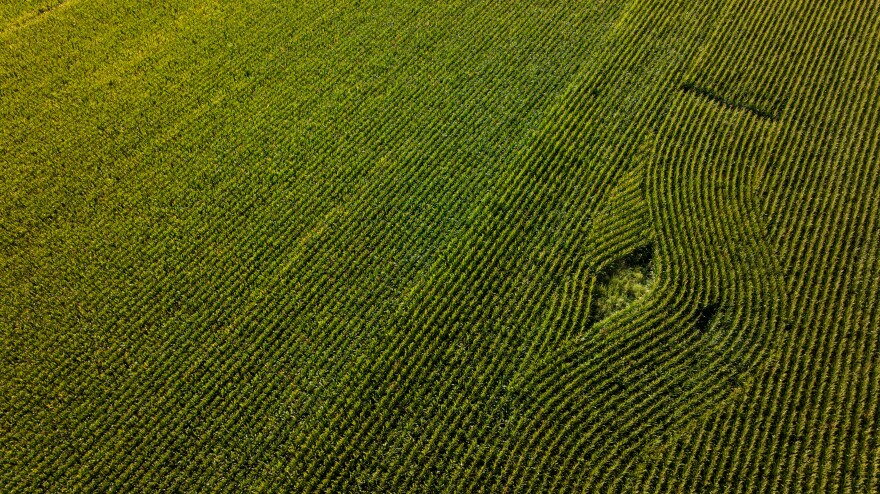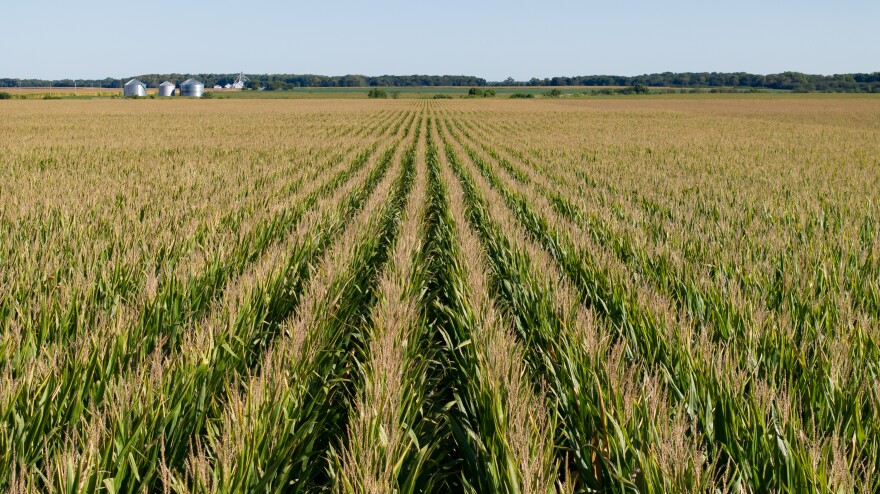A couple years ago, farmer Chad Moore’s seed dealer was looking for people to try out a new product — short corn, from the agriculture company Bayer.
“I had never heard of it before,” Moore said. “I've always been kind of looking to do things a little bit different, try things out on the farm year after year. And I thought, ‘Sure, I'll try a box of that and see what happens.’”
Moore is a third-generation farmer who grows corn and soybeans on about 1800 acres in central Illinois, south of Decatur. He's also the self-described guinea pig among farmers in his area and is now in his second year growing the short-stature corn, called the Preceon Smart Corn System.
The new variety doesn’t look too different from the road. It’s only about three to four feet shorter than the rows of corn you see as you drive through states like Illinois — corn that is largely used to feed livestock and make ethanol fuel.
But the small aesthetic difference hides some big changes in how the corn can be grown and what its potential outcomes might be. Those changes have multiple agriculture companies and researchers all working on shrinking their corn – and betting that shorter varieties might become more widespread in the future.
The U.S. produces more than a third of the world’s corn, and most of that grain comes from a swath of the central U.S. called the Corn Belt. It’s such a dominant crop that at certain times of year, a yellow wave can be seen from space, stretching from the Dakotas to Ohio.
Now, this new variety of smaller corn might bring a big change to the region. But that’s only if farmers decide it’s worth the switch.

Shorter corn, tall benefits
It’s early days, but there’s some hype around short-stature corn in the Midwest right now.
Besides Bayer, several other companies are also selling or developing shorter corn hybrids. One is Corteva Agrisciences, which is currently testing reduced-stature corn and plans to start selling its own variety in the next few years.
Farmers are really curious about it, said Corteva’s vice president of biotechnology, Wendy Srnic.
“There's a lot of optimism, a lot of excitement, and we can't wait to get it in growers’ hands so they can see what they think of it,” Srnic said.
Midwestern corn experts say shorter corn has three main advantages, compared to traditional varieties. For one thing, it’s less likely to get knocked over in strong wind storms, like the derechos that have blown through the Midwest in recent years.
Alex Renaud, Bayer’s technical lead for North American Corn Business, grew up in central Iowa and his dad and uncle still farm there. A 2020 derecho caused a near total loss for his family, knocking their corn stalks to the ground.
“The conversation was, ‘Would a shorter-stature hybrid or Preceon have helped us?’ And the answer would have been, ‘Yes,’” Renaud said. “We would have had a crop to be able to harvest.”
Shorter corn is also much easier to treat with fertilizer, fungicides and pesticides.
“With tall corn, you kind of hit a window where you can't get into the canopy, you can't get into the field anymore,” said Srnic, of Corteva Agrisciences.
When the corn is shorter, farmers can treat their fields throughout the growing season with rolling sprayers, rather than having to spray from an airplane or forgo treatment. That’s important in a summer like this year’s, when high humidity causes fungal diseases.
Shorter corn can also be planted more densely without affecting the health of the plants, which translates to more corn to harvest and sell.
When tall corn is planted too close together, it experiences what breeders call stress, which leads to skinnier stalks, smaller roots, and a propensity to fall over.
Stine Seed Company bred its own shorter corn by accident decades ago, partially because the founder was trying to save money, according to his son Warren Stine.
“My dad is a real, I don't know if I want to say penny-pincher, but he likes to watch his dollars and cents,” said Stine, who works in corn research for the company.
While testing corn varieties, the company cut costs by thinning the number of plants in their plots less often. As a result, they had denser plantings, and found that shorter plants could handle it.
“The leaf architecture is very, very upright,” Stine added. “You can crowd these plants together, and they'll tolerate that quite, quite well.”
The result of dense plots is a benefit that trumps the others: higher yield.
“Higher yield is better for everyone,” said Katie Murphy, a scientist at the Donald Danforth Plant Science Center. “It's better for farmers. It's better for consumers. It's better for the environment. We can grow more food in less square footage.”
On Chad Moore’s fields, he’s planted about 20% more Preceon corn per acre compared to the taller variety. That should mean more ears to make grain.
“Whether the corn’s short or tall, I want to make sure I got the yield out there,” Moore said. “That's the main goal of anything.”

Next Green Revolution?
Shorter plants and higher yields have some wondering if this might echo a pivotal moment in agricultural history: the Green Revolution.
“I think shorter stature corn, the Preceon Smart Corn System, will go down as a revolutionary moment for agriculture, very similar to what Norman Borlaug did,” said Renaud from Bayer.
In the middle of the 20th century, scientist Norman Borlaug developed new wheat varieties that dramatically increased yield, earning him a Nobel Peace Prize for his transformative work that helped cut down famine worldwide. Eventually, other plant scientists developed similar methods, increasing yields for other crops.
“Everyone, both academic and industry, has been talking about shorter crops in general since the Green Revolution, because that has a proven track record of increasing yields,” said Murphy at the Donald Danforth Plant Science Center.
But Iowa State University professor Pat Schnable said it’s too early to compare short corn to the Green Revolution.
“Many millions of people are alive today that wouldn't have been alive if the Green Revolution hadn't happened,” Schnable said. “We don't have that kind of impact yet with short corn, but it does have a lot of potential.”
Shorter corn is a gradual change in the grand history of this plant, Schnable said, which started as a large grass and has been domesticated over the course of about 10,000 years. He thinks companies and scientists are focused on height in part because it’s a trait that is easy to change.
“In the simplest case, with a single gene, you can make the plant shorter,” Schnable said. “There are benefits, and it's possible. It's doable, which is not true for some traits we would care about.”
But there’s more that scientists would love to do. And as technology advances, even more dramatic changes are becoming possible.

Fantasy corns
Stine, Corteva and Bayer all say their corn is shorter thanks to traditional plant breeding. Eventually, Bayer’s Alex Renaud said the company will use a gene editing approach when developing future short corn varieties.
While much can be achieved with breeding, gene editing techniques have become increasingly popular in the past decade. These approaches allow scientists to narrowly focus on traits, without the baggage of other changes that come with breeding, said researcher Katie Murphy.
“We can go in really targeted to try and adjust those genes without having to change many, many, many genes in a plant's genome,” she said.
At Iowa State, Schnable is thinking even bigger. His team is using a computer program to dream up designer corn varieties and test them virtually.
“What's the optimal number of leaves? What's the optimal width of the leaves?” Schnable said. “So we come up with what we think is the optimal plant, and then we can breed towards that, or we can use technologies like genome editing to generate plants like that.”
But the question is, will farmers plant these new varieties of corn? Schnable recently asked a group of Iowa corn farmers if they would be interested in a crop that looked very different, but had a big increase in yield.
“The first reaction of some of the farmers was, ‘No, it's too weird,’” Schnable remembered. “But some of the other ones said, ‘Look, let [him] develop this thing, and if it in fact yields 10 to 20% more, I bet we would grow it.’”
Up to the farmers
This year, Bayer’s Preceon short corn is on about 100,000 acres in the Midwest, which is a small fraction of the more than 95 million acres of corn U.S. farmers planted in 2025.
Whether or not short corn takes off will be up to growers, said Corteva’s Srnic.
“I think growers will tell us,” Srnic said. “They're going to decide, and we're going to be very much listening to what they're thinking, what they're seeing, what their experiences are.”
There’s a precedent for this, according to Schnable. Hybrid corn was first commercialized in the 1930s. Within about four or five years, Iowa went from zero hybrid corn to more than 90%, Schnable said.

“Farmers are very quick to adopt these things if they work and provide value,” he said. “So if the short corn performs as we might hope it will and has the benefits that we've described, I suspect it will get widely adopted very quickly.”
Even if the Preceon on Moore’s farm works out well, he’s not sure it will ever be 100% of his operation. He said it may not be right for more rolling topographies or rougher soil.
Still, he’d like to see more of it. And other farmers in Moore’s area have been intrigued by his experiment.
“I think they're looking at the guinea pig and wanting to see what my response or what my outcome is,” Moore said. “Farmers are a very curious bunch. Maybe not always wanting to be the first one out there, but they're more than happy to follow suit afterwards if it's positive.”
This story was produced in partnership with Harvest Public Media, a collaboration of public media newsrooms in the Midwest and Great Plains. It reports on food systems, agriculture and rural issues.





